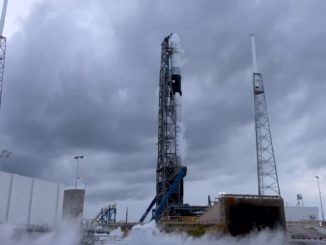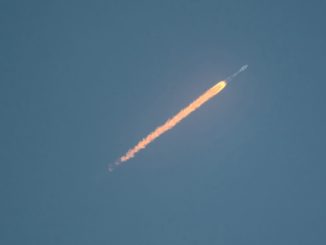STORY WRITTEN FOR CBS NEWS & USED WITH PERMISSION
Near the end of a ground-shaking test firing of Northrop Grumman’s solid-propellant Castor 600 rocket motor — the first stage of a new booster being designed to launch spy satellites and other national security payloads — a major part of the rocket’s big nozzle appeared to break apart, littering the test site with shards of debris.
Built by Northrop Grumman (formerly Orbital ATK), the rocket was mounted horizontally at the company’s test stand in Promontory, Utah. The Castor 600 motor, which will be used as the first stage of the company’s new intermediate-class Omega rocket, appeared to fire normally for the first minute and 58 seconds or so.
At that point, just a few seconds before the rocket’s solid propellant was exhausted, at least part of the nozzle appeared to break into multiple fragments. Even so, Kent Rominger, a former shuttle commander and now a Northrop Grumman vice president, called the test a success.
“It appears, everything worked very, very well on this test,” he told reporters. “And at the very end when the engine was tailing off, we observed the aft exit cone, maybe a portion of it, doing something a little strange that we need to go further look into.”
Northrop Grumman webcast the test firing and to the untrained eye, a significant portion of the nozzle appeared to suddenly shatter toward the end of the burn, breaking into multiple fragments that shot away from the booster’s still-rushing exhaust plume.
The Castor 600 booster, similar in design to the boosters used to launch space shuttles, was heavily instrumented for its first test firing with more than 700 channels of telemetry being recorded. For the test Thursday, the booster’s propellant was heated to 90 degrees before firing, allowing it to generate slightly higher-than-normal thrust.
Rominger said the observed nozzle anomaly that long after ignition might not have had a major impact during an actual flight, but “we’ve got to get through the data.”
“The quick-look data we’ll be getting within several hours, but then we have to dig into all that data and analyze kind of what it is you’re talking about to see, in fact, what happened,” he said. “So what you saw was at the very end of the tail off, you could have had a very normal, nominal thrust profile, but the truth is we need to go pull the data to analyze that.”
Northrop Grumman is building more powerful solid-propellant boosters for NASA’s huge Space Launch System rocket, which will be used in the early 2020s to launch astronauts back to the moon. It was not immediately known what impact, if any, the test anomaly Thursday might have on the SLS program.
But Rominger downplayed commonality between the two designs.
“This nozzle is a little bit different, a little bit more of a commercial nozzle than SLS,” Rominger said. “So there are distinct differences between these nozzles.”
In October 2018, Northrop Grumman, United Launch Alliance and Blue Origin won Air Force contracts totaling more than $2 billion to develop next-generation rockets capable of boosting high-value national security payloads into orbit. Northrop Grumman’s share for development of the Omega rocket was $791.6 million. Two of the new rockets will be selected for military use in a second competition.
Northrop Grumman is developing two versions of the three-stage Omega rocket, one featuring the Castor 600 first stage motor and the other a more powerful Castor 1200. Both versions will use Castor 300 solid-propellant second stages and an upper stage powered by hydrogen-fueled RL10C engines provided by Aerojet Rocketdyne.
Smaller strap-on solid-propellant motors can be attached to the first stage for additional lift-off power.
The company said earlier that two full-scale static test firings, one of the first stage and one of the second, would qualify the intermediate version of the rocket for an initial test flight in 2021. Operational flights could begin in 2022.
A test firing of the Castor 300 upper stage motor is planned for the August-September timeframe, but that assumes no major delays due to the nozzle anomaly or any other issues.



